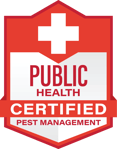Public Health Certified
Rodent Control
Rodent control service begins with a complete pest inspection to Public Health certified standards. We find how rodents are gaining into your San Diego home or business. We determine the species and amount of rodent activity. We survey conditions that contribute to increased rodent populations. And then, we get to work on rodent control.
 Rodent control service may include:
Rodent control service may include:
- Sealing entry points (also called exclusion work)
- Rodent trapping
- On-going rodent service, including rodent baiting
- Rodent debris clean out of attics and insulation
- Recommendations for making your property less interesting to rodents
Rodents are a Public Health Threat
We take rodent control very seriously and so should you. Throughout San Diego County and across the state, mouse and rat populations are surging. Rodent infestations increased by an estimated 50% in 2019. Rodents in the home pose serious potential health risks. They contaminate human foodstuffs, countertops, eating utensils, and bedding with their urine, feces, hair, pathogens, and parasites. Cases of plague and hantavirus linked to rats and mice have occurred in San Diego County. Salmonella, rat bite fever, tapeworms, ringworm, typhoid fever, and typhus are also spread by rodents and have occurred in Southern California.
Our rodent control services are Public Health certified. With training, testing, and protocols that all meet the most exacting standards, you can feel confident in the quality of our rodent control services. Our staff has advanced training in rodent detection, prevention, and rodent control. We’re happy to share our knowledge with you as we work together to protect your home or business from rodent infestation.

Your Role in Rodent Control
Thrasher Pest Control follows an integrated pest management (IPM) approach to rodent control. Successful, long-term control requires your participation. Our technician will identify structural or environmental conditions that provide rodents with food, water, or shelter. Correcting some items are listed in our scope of work. Here is what you can do to help:
- Always keep garbage cans covered.
- Pick fruit, nuts, and vegetables as they ripen, and throw away or compost fallen fruit as far away from your home as possible.
- Feed pets during daylight hours only and remove uneaten food right away. Store pet food in rodent-proof containers.
- Clean up bird feeder spillage or eliminate bird feeders. Store bird seed in rodent-proof containers.
- Avoid storing food in garages and storage sheds at night unless in rodent-proof containers.
- Some organic fertilizer is attractive to rodents (blood meal, bone meal, and fish emulsion) Store organic fertilizer in rodent-proof containers.
- Remove all trash and debris in and around your home.
- Stack woodpiles, lumber, crates, boxes, and gardening equipment at least 18 inches above the ground, and 12 inches away from fences and walls.
- Trim trees, bushes and vines to at least 4 feet away from the roof.
- Remove heavy vegetation such as ivy, bougainvillea, juniper, jasmine, and pyracantha away from buildings and fences.
- Put rat guards on palm trees to prevent rats from nesting in the fronds.
Use “Wet-cleaning” Methods to Clean-up after Rodents
We highly recommend following the CDC guidelines when cleaning up after rodents. Rats and mice carry and shed many human pathogens. Take precautions before and during clean-up of rodent-infested areas.
From the Centers for Disease Control and Prevention:
First, clean up any urine and droppings
Before starting clean-up of the space, ventilate the space by opening the doors and windows for at least 30 minutes to allow fresh air to enter the area. Use cross-ventilation and leave the area during the airing-out period.
When you begin cleaning, it is important that you do not stir up dust by sweeping or vacuuming up droppings, urine, or nesting materials.
- Wear rubber, latex, or vinyl gloves when cleaning urine and droppings.
- Spray the urine and droppings with a disinfectant or a mixture of bleach and water and let soak 5 minutes. The recommended concentration of bleach solution is 1-part bleach to 10 parts water. When using a commercial disinfectant, following the manufacturer’s instructions on the label for dilution and disinfection time.
- Use a paper towel to pick up the urine and droppings, and dispose of the waste in the garbage.
- After the rodent droppings and urine have been removed, disinfect items that might have been contaminated by rodents or their urine and droppings.
Next, clean and disinfect the whole area
- Mop floors and clean countertops with disinfectant or bleach solution.
- Steam clean or shampoo upholstered furniture and carpets with evidence of rodent exposure.
- Wash any bedding and clothing with laundry detergent in hot water if exposed to rodent urine or droppings.
Lastly, remove gloves and thoroughly wash hands with soap and water (or use a waterless alcohol-based hand rub when soap is not available and hands are not visibly soiled).
Specific cleaning recommendations
The complete CDC guide to cleaning up after rodents includes special instructions for the topics below.
- Clothing, Bedding, Stuffed Animals
- Carpets/Furniture
- Books, Papers, and other Non-washable items
- Cabins, Sheds, Barns, or Other Outbuildings
- Attics, Basements, Crawlspaces, and Other Storage Areas
- Cleaning and Disinfection of Vehicles with Rodent Infestations
- Air Ducts (heating and cooling ventilation systems)






